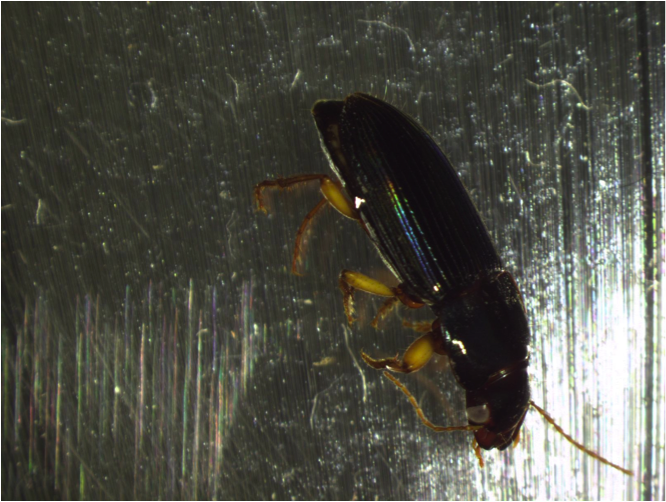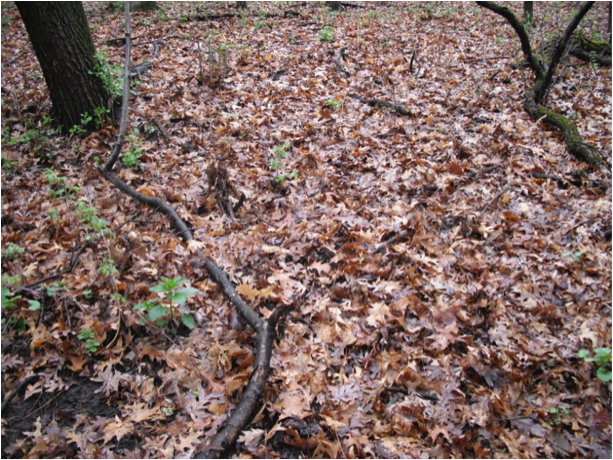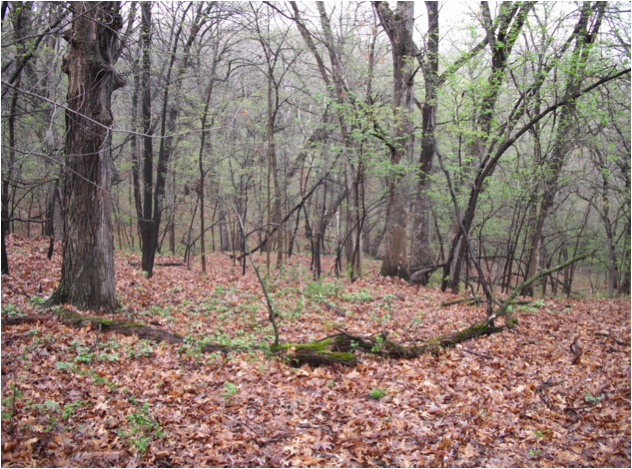Mealworm Beetle
Contact
Katharine Ordway Natural History Study Area9550 Inver Grove Trail Inver Grove Heights, MN 55076 651-455-6204 (On Site)
651-696-6230 (On Campus)
andersonm@macalester.edu
Biotic Inventory: Documenting Diversity at the Katharine Ordway Natural History Study Area
Tenebrio molitor, Yellow Mealworm Beetle
Taxonomy 1
Kingdom Animalia
Phylum Arthropoda
Class Insecta
Order Coleoptera
Suborder Polyphaga
Superfamily Tenebrionoidea
Family Tenebrionidae
Subfamily Tenebrioninae
Genus Tenebrio
Species molitor
Common Names: Yellow Mealworm, Yellow Mealworm Beetle, Flour Beetle, Golden Grub, Darkling Beetle 2, 8
Diagnostic Characteristics
The Yellow Mealworm Beetle resembles ground beetles according to its similar size, shape, and dark color. The Yellow Mealworm will generally grow to be slightly larger than .5 inches long and at its adult stage will become a dark brown or black color3. However, a few key characteristics differentiate the Yellow Mealworm Beetle from other beetles. The Yellow Mealworm Beetle has several distinct features in regards to its abdomen shape and design. Like many other beetles the Yellow Mealworm has its abdomen evenly split into two segments with its wings hidden safely underneath. The Mealworm Beetle’s distinct feature is the evenly divided, linear grooves running along the entire length of its abdomen. A less noticeable yet dissimilar trait of the Tenebrio molitor is that it has only four tarsal segments on its hind legs, as opposed to the five that most ground beetles possess. This characteristic results in the Mealworms inability to move around as quickly as other ground beetles4. The Black Mealworm Beetle is a very similar beetle to its close relative the Yellow Mealworm Beetle. The key variations between these two beetles are in regards to the size and shape of their thorax and abdomen. The Yellow Mealworm has a more rectangular shaped abdomen rounding off at its end, as well as a wider thorax equal to the width of its abdomen. The Black Mealworm has a more spherical shaped abdomen that forms a sharper tip at its end, along with a noticeably thinner thorax when compared to the width of its abdomen4, 5. Whether obvious or difficult to perceive, the Yellow Mealworm Beetle has numerous features that make it unique and distinguishable to itself.
Ecology
The Katherine Ordway Natural History Study Area is home to an immense amount of diversity. Its river, prairies, forests, and ponds house many different species. The forest’s leaf-litter is home to a tremendous amount of varying invertebrates, along with some small vertebrates, and it provides the soil and surrounding plants with necessary nutrients. The leaf-litter is one of the main habitats in which an adult Yellow Mealworm Beetle will choose to reside. Yellow Mealworm Beetles prefer the darkness and being in contact with other objects. Due to the leaf-litters abundant covering and high resource for nutrients, they will often be found there as well as underneath rocks and logs5. Yellow Mealworm larvae will also be found around locations of human food storage7.

These beetles are notorious for being scavengers and decomposer of the earth’s floor. They will eat decaying leaves, sticks, grasses, plants, as well as insects and animals3, 5. This can be good for the environment because they will eat organic matter that is not usually eaten by other organisms. They are mostly nocturnal but will also be seen active in dark environments during the day3, 5. However, they can also be pests for grasses, their seedlings, and grains5. These beetles do not have much contact with other live organisms. Due to this, they may display a very unique behavior when disturbed. When they feel endangered they flip onto their head, taking a defensive position. The beetles then spray chemicals from their rear scent gland towards the danger. The Yellow Mealworm Beetle’s combination of positive and negative contributions to the environment along with its lack of contact with other organisms makes this beetle even more unique.
Life History
Yellow Mealworm Beetle’s have very distinguishing life cycles. They undergo a process referred to as complete metamorphosis. This life cycle is comparable with butterflies and consists of four distinct life stages6. The first stage is as an egg. The female beetle will lay approximately 500 eggs. The eggs are white, bean shaped, and about 1.25mm in length. They are laid in the soft ground and will hatch into larvae after 1-2 weeks2. When the larvae exit the eggs, they are referred to as Yellow Mealworm since they have still not become a beetle yet are an active organism. These larvae are notorious for being pests in barns, mills, and other areas of human food storage. They undergo between 9-20 molts, shedding of their outer shell, and grow slightly more with each molt. The Yellow Mealworm will reach a length of approximately 25mm7. When the larvae are ready to pupate they spend several days as prepupae near the surface of the food they are infesting7. While in the pupae stage they are between .5-.75 inches in length and change from white to black as the beetle is about to emerge5. Unlike a butterfly, the pupae have no outer covering. Depending upon the temperature the pupae will remain for 3-30 days. The pupae will appear motionless though inside the mealworm will be turning into a beetle2, 6. When the beetle emerges as an adult, they will survive for about an additional 30 days. During this time they will mate, lay their eggs, and will repeat the process. Accumulating all four cycles, their total life expectancy is 3-5 months5.
During their short lives they encounter many dangers. While in the wild, birds are their most prominent predator. However, as of recently, humans have become even greater predators to the Yellow Mealworm. Humans breed and sell them for bird food and fish bait while they are in the larvae stage of their life cycle. Thus, the life of a Tenebrio molitor can vary greatly between each individual in their species.
Distribution
Scientists believe that Mealworms evolved from Eurasia and have spread throughout the world because of human activity8. Currently, Yellow Mealworm Beetle’s reside throughout the northern United States, Western Europe, and parts of Australia8, 9. Minnesota and the rest of upper U.S. region make a great location for them to thrive because of the forests and the many farms which they invade to infest on the feed.
Voucher Information
The Yellow Mealworm Beetle sample was collected at the top of a hillside in a woodland area at Katherine Ordway Natural History Study Area in Inver Grove Heights, MN. The specimen was underneath the leaf-litter which was very moist at the time.

References
1. Bug Guide. 2007. http://bugguide.net/node/view/101010
2. Australian Wildlife. 2010. http://74.125.113.132/search?q=cache:e4drNcSIGJMJ:www.ozanimals.com/Insect/Yellow-Mealworm/Tenebrio/molitor.html+yellow+mealworm+common+names&cd=2&hl=en&ct=clnk&gl=us
3. First Class Pest Solutions. 2002. http://74.125.113.132/search?q=cache:ChyoPhfLS40J:www.firstclasspest.com/index.php%3Foption%3Dcom_content%26view%3Darticle%26id%3D67%26Itemid%3D83+yellow+mealworm+beetle+identification&cd=10&hl=en&ct=clnk&gl=us
4. Stored Product Insects. 2003. http://www.the-piedpiper.co.uk/th7h.htm
5. The University of Arizona: Center for Insect Science Education Outreach. 1997. http://insected.arizona.edu/mealinfo.htm
6. Foss Web. 2009. http://lhsfoss.org/fossweb/teachers/materials/plantanimal/tenebriobeetles.html
7. Hort Fact. 1998. http://www.hortnet.co.nz/publications/hortfacts/hf401013.htm
8. Immuno CAP. 2008. http://www.immunocapinvitrosight.com/dia_templates/ImmunoCAP/Allergen____28207.aspx
9. Encyclopedia of Life. 2010. http://www.eol.org/pages/1041700
Compiled by David Melms,
Biodiversity & Evolution (BIOL 270), Professor Sarah Boyer. Spring 2010.
Specimen collected at Macalester College’s Katharine Ordway Natural History Study Area on April 15, 2010.